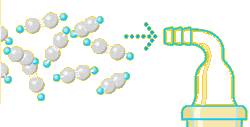Plastics that imitate metals
 |
Plastics are polymers, molecules formed of many identical units bound to each other like pearls in a necklace. For a polymer to be electrically conductive it must “imitate” a metal – the electrons in the bonds must be freely mobile and not bound fast to the atoms. One condition for this is that the polymer consists of alternate single and double bonds, termed conjugated double bonds. Polyacetylene is the simplest possible conjugated polymer. It is obtained by polymerisation of acetylene, shown to the left. |
Nobel Prizes and laureates
Eleven laureates were awarded a Nobel Prize in 2023, for achievements that have conferred the greatest benefit to humankind. Their work and discoveries range from effective mRNA vaccines and attosecond physics to fighting against the oppression of women.
See them all presented here.
See them all presented here.
Explore prizes and laureates
Look for popular awards and laureates in different fields, and discover the history of the Nobel Prize.
